English Electric Lightning
T Mk.4 & T Mk.5
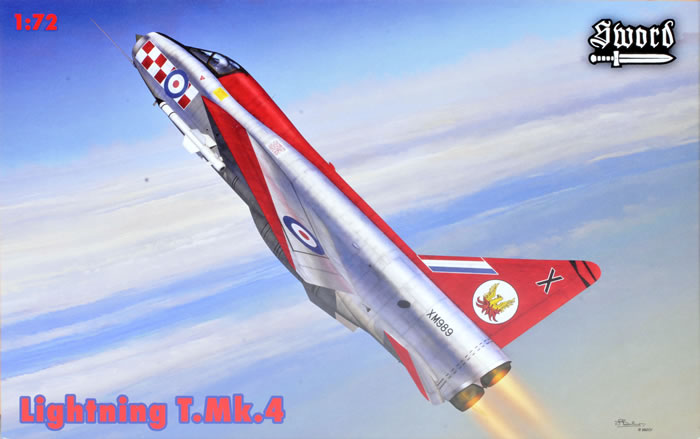
Sword, 1/72 scale
S u m m a r y : |
Catalogue Numbers: |
SW72079 - Lightning T Mk.4
SW72079 - Lightning T Mk.5 |
Scale: |
1/72 |
Contents & Media |
Version |
Grey
Styrene |
Clear
Styrene |
Resin |
PE Fret |
Decal Options |
T Mk.4 |
68 |
2 |
3 |
1 |
2 |
T Mk.5 |
71 |
2 |
3 |
1 |
3 |
Price: |
Available on-line from these stockists: |
Version |
Hannants |
Squadron |
Modelimex |
West Coast Hobbys |
HLJ |
T Mk.4 |
£12.49 |
US$29.24 |
€14.46 |
Can$23.50 |
¥2,340 |
T Mk.5 |
£12.49 |
US$29.24 |
€14.46 |
Can$23.50 |
¥2,340 |
Click here for currency conversion. |
Review Type: |
First Look. |
Advantages: |
Accurate in appearance, good production quality, very nice surface and cockpit detail. Good value too, from the right supplier. |
Disadvantages: |
None apparent. |
Conclusions: |
These are very good limited-run kits, exhibiting almost long-run characteristics and quality. They are accurate in appearance, well engineered with very nice surface and cockpit detail, and look straightforward to build. I think that they also represent excellent value from the right supplier. These are the best 1/72-scale Lightning T.4 and T.5 kits to date by far. I definitely recommend both boxings. |
Reviewed by
Mark Davies

Sword's 1/72 F2H-2P Photo Banshee and F2H-2 Banshee
are available online from Squadron.com
The English Electric Lightning was a supersonic jet fighter aircraft of the Cold War era. It was designed and manufactured by English Electric, who was subsequently integrated into the unified British Aircraft Corporation, after which point the aircraft was marketed as the BAC Lightning. The Lightning was the only all-British Mach 2 fighter aircraft and was the first aircraft in the world capable of supercruise.
The Lightning was renowned for its capabilities as an interceptor; pilots commonly described it as "being saddled to a skyrocket". It was powered by the Rolls-Royce Avon turbojet engine; each aircraft had two Avon engines in an unusual stacked arrangement in the main fuselage with the cockpit perched on top. The Lightning was developed to counter increasingly-capable bomber aircraft, and thus had remarkable climb, altitude and speed flight performance in order to perform rapid interception. The type was subsequently developed for greater range and speed, as well as to perform reconnaissance and ground-attack missions.
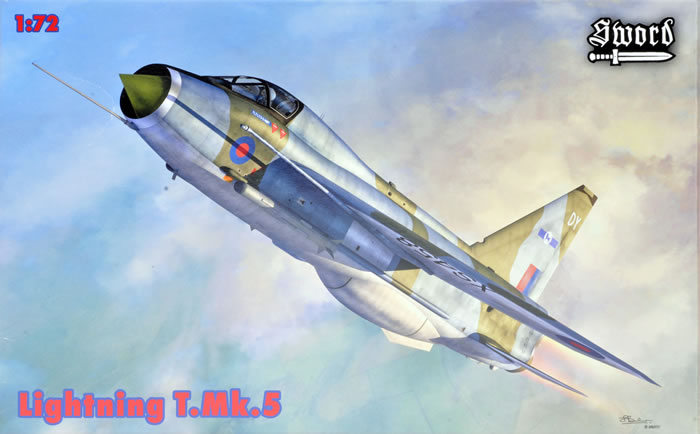
The Lightning was used by the Royal Air Force, Royal Saudi Air Force and the Kuwait Air Force. It was operated as the RAF's primary interceptor for more than two decades, during which the type was never required to shoot down a hostile aircraft. Following retirement in the late 1980s, many of the remaining aircraft became museum exhibits; until 2010, three examples were kept flying at "Thunder City" in Cape Town, South Africa. In September 2008, the Institution of Mechanical Engineers conferred on the Lightning its "Engineering Heritage Award" at a ceremony at BAE Systems' site at Warton Aerodrome.
The Lightning T.4 was developed as a two-seat side-by-side training version, based on the F.1A. Two prototypes and 20 production airframes were built, with two aircraft later being converted to T.5 prototypes, and two more to T.54’s. The T.5 was similar to the T.4, but based on the F.3 with its larger flat-topped tailfin. 22 production aircraft were built, with one former RAF aircraft later being converted to T.55 for Saudi Arabia.
Source: Wikipedia. I think that this is one of Wikipedia’s more interesting aircraft entries; it gives some insight as to the Lightning’s stunning performance and outstanding handling. It is worth reading if you want to know more about this remarkable and unique design.
Previous 1/72 Scale Lightning Trainer Kits
The most common Lighting two-seater kit in The One True Scale was by Matchbox, but unfortunately it was a T.55 export version with the large belly tank and later pattern wings (it was derived from Matchbox’s Lightning F.6 kit). It is unsuited to the more popular RAF variants without cross-kitting and conversion work. Matchbox’s kits are pretty good as far as 20th Century 1/72 Lightings go; offering the only T.55, and probably the best overall injected F.6 and until Airfix’s recent F.2A release (to be followed by the very similar F.6). The Matchbox kit had a generally good shape, but suffered from rather heavy raised surface treatment and simplified details. It has also been re-boxed by Revell.
Aeroclub offered vac-form fuselages to convert the Airfix F.1A and F.3 kits to a T.4 or T.5 respectively. However, like the Airfix kits, these were very basic. Airmodel also offered a vac-form T.5 fuselage conversion.
Whirlykits produce an all-resin T.4 kit. Sadly, in my opinion at least, this is a typically British-made resin kit, with some quite rough mastering (uneven panel lines etc), clunky white metal parts (some being good only for the waste-bin). It reminds me of a Magna kit, and fails to measure up to the best resin kits produced in Eastern Europe, the Ukraine and Russia. Of course, I do not wish to tar all Brit producers with the same brush; some of the better ones outsource their resin production to the Czechs, and offer some very nice products as a result.
Neomega makes a nice resin T.4 conversion matched to Trumpeter’s F.1A kit, and presumably, it can be made into a T.5 if used with Trumpeter’s F.3 kit. This was undoubtedly the best route to a modern nicely detailed RAF two-seat Lightning in 1/72 scale, until now...
Contents
The kit comes in a typically Czech end-opening box with digital artwork on the front. The plastic parts and decals come in a zip-lock bag, with the clear and coloured PE parts further enclosed in small bags of their own. A little surprisingly, the three resin pieces are loose in the outer bag with the main sprues.
The instructions provide a parts map and easy to follow diagrammatic assembly format. The diagrams are well drawn, and in fact are far better than some mainstream brands. There is also a brief history of the aircraft. Generic paint colours are given in Czech and English, with all other text in English. The painting and decal guides use adequate black & white shaded drawings in the instructions, and colour profiles on the rear of the box. I feel that Sword could do better here, and cross-reference the colours using BSC or FS codes equivalents, or list popular paint brand numbers.
The Kit
Both are typical Sword kits with cleanly moulded parts, very fine surface detail, and narrow sprue gates. There is just a little hint of flash in places, but this is easy to deal with. Parts break down is conventional for the type. For the sake of simplicity, I shall use the singular, “kit” from here on, as they share the same sprues, with only differences between the being the shape of the applicable tailfin, the optional refuelling probe for the T.5, the missiles carried, and of course the decals provided.
The cockpit tub is, according to the parts map at least, supposed to be made of resin, but in my examples was clearly a styrene part; complete with prominent raised ejector-pin mark and side-cutter mark where it has been removed from a sprue (although it is not from either off the two main sprues). The resin ejection seats are garnished with coloured PE harnesses and firing handles.

Coloured PE also provides the instrument panel (fitted to a styrene backing plate), as well as side-consol detail and radarscope screens.
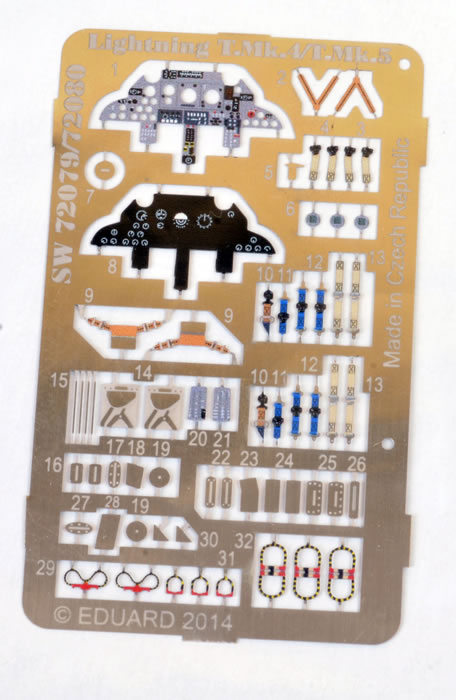
The control columns and rear cockpit bulkhead are styrene, as is the cockpit coaming. There are no rudder pedals provided, but I doubt that they could be seen anyway if they were. The cockpit should look very good when finished.
The fuselage halves enclose a number of sub-assemblies in addition to the cockpit. These include the combined radome/inlet shock-cone and nose-wheel well, which the instructions advise you to fill with ballast; lower engine compressor face; and very nice resin exhaust nozzles with deep jet pipes, the ends of which are capped with styrene pieces incorporating flame-holder detail. The two-piece canopy can be modelled closed or open, with a telescopic ram included for the latter position. The fuselage’s main structure is completed by the addition of the tailfin applicable to the version being modelled.
The wings are split between upper and lower halves, as would be expected; and unlike some limited run kits, the trailing edges are fortunately included with the upper halves, thus ensuring a sharp finish. The flaps are separate parts, and can be positioned in accordance with the builder’s choice. The main-wheel wells are boxed in and include some basic interior detail. The undercarriage is nicely moulded with good levels of detail. The nose-wheel is a separate item, rather than the more common approach of moulding this part with the nose-leg. The tailplanes are single pieces, and the instructions helpfully provide a head-on view with angular measurements indicating the correct relationship for these and the wings to the fuselage.
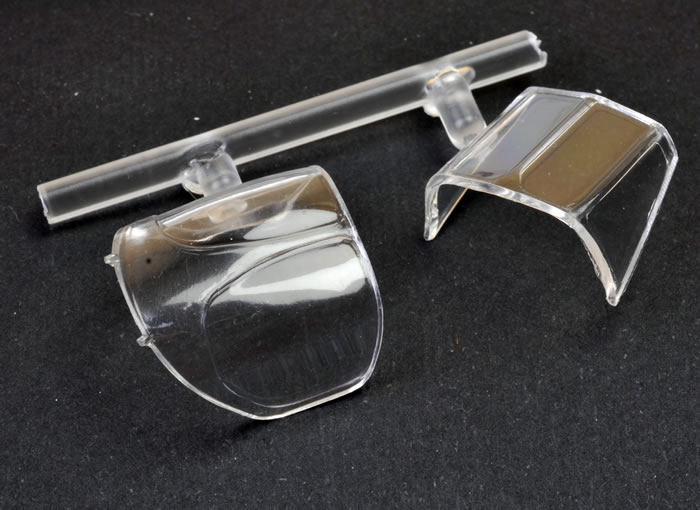
Parts for a pair of both Firestreak and Redtop or missiles are provided, along with their respective launch rails. Both have quite thin wings and guidance fins for injection-moulded items. The respective instructions show the Firestreaks as being for the T.4 and the Red Tops for the T.5; but I think any Red Top capable Lightning version could also carry the older Firestreak missile. Of course, the aircraft can also be depicted without missile armament.
Not much remains to mention; the long nose pitot, a number of PE blade antennae to add to the fuselage, and the ventral fin to add to the belly tank. There is also an optional refuelling probe that fits under the port wing root of the T.5, which is applicable to two of the three decal options supplied with the kit.,
Overall, I should think that this kit should be a simple and enjoyable one to build. A Sword release-preview featured here on HyperScale in March includes an image of the assembled but unpainted model. This image and my “First Look” examination lead to me to believe these kits are accurate in appearance.
Marking Options
Eduard prints the decals, and these are well registered with what appears to be good opacity. I am sure they will prove to be excellent to apply based on my experience of this brand. The instructions provide a page with four-view drawings covering the extensive stencil placement, and this includes missile markings. The subjects covered are listed below:
T Mk.4:
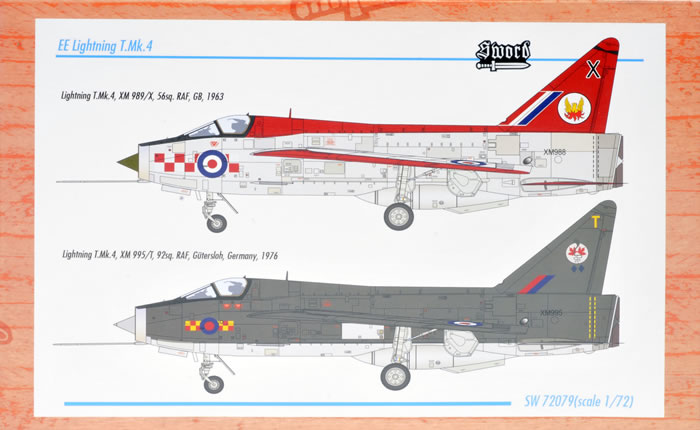
- XM989/X, 56 Sqn RAF, Great Britain, 1963; and
- XM995/T, 92 Sqn RAF, Gutersloh, Germany, 1976.
T Mk.5:

- XS452, 226 OCU, RRAF Lakenheath, Great Britain, 1970;
- XS458/DY, LTF RAF, Great Britain, 1988; and
- XV328/DU, LTF RAF, Alconbury, Great Britain, 1987.
If these options do not appeal, you could consider the 20 options offered by Xtradecal across two decal sets that I reviewed here on HyperScale in June.
These are very good limited-run kits, exhibiting almost long-run characteristics and quality. They are accurate in appearance, well engineered with very nice surface and cockpit detail, and look straightforward to build. I think that they also represent excellent value from the right supplier. These are the best 1/72-scale Lightning T.4 and T.5 kits to date by far. I definitely recommend both boxings.
Thanks to Sword Models for this review sample.
Review Text Copyright © 2014 by Mark Davies
Review Images Copyright © 2014 by Brett Green
Page Created 16 July, 2014
Last updated
16 July, 2014
Back to HyperScale Main Page

|
